With the 100th anniversary of the founding of the International Union of Pure and Applied Chemistry (IUPAC) upon us, there is much to reflect on. The Union in seeking to advance the chemical sciences internationally has reached beyond technical and scientific dimensions of its work, making contributions that benefit the greater good of our world. Sometimes these contributions are seen in areas that might even seek to limit or curtail certain chemical activities, for example chemical weapons. IUPAC’s commitment to supporting the norms of disarmament and non-proliferation of chemical weapons has been exemplified through their work in collaboration with and in support of the Organisation for the Prohibition of Chemical Weapons (OPCW).
1A Unique Partnership
2The Organisation for the Prohibition of Chemical Weapons and the Chemical Weapons Convention
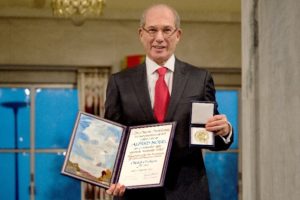
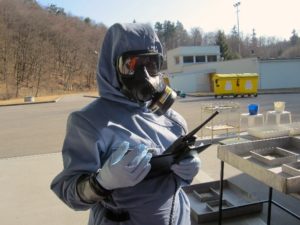
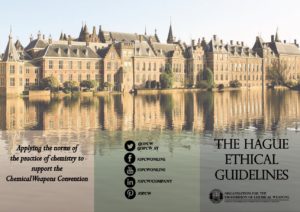 Based in The Hague, in The Netherlands, OPCW serves as the implementing body for the Chemical Weapons Convention (“the Convention”), an international (“multilateral” in the jargon of diplomacy) chemical weapons disarmament and non-proliferation treaty [1]. The Convention entered into force in 1997 and today includes 193 State Parties (the nation states obligated to the treaty) which represent all but four of the world’s internationally recognized States [2]. These States have committed themselves to never develop, produce, otherwise acquire, stockpile or retain chemical weapons; to never transfer chemical weapons (directly or indirectly) to anyone; to never use, or undertake any military preparations to use, chemical weapons; and never to assist, encourage or induce, in any way, anyone to engage in any activity prohibited under the Convention [1]. The Convention is the first disarmament treaty to introduce a verifiable ban on an entire class of weapons of mass destruction.
Based in The Hague, in The Netherlands, OPCW serves as the implementing body for the Chemical Weapons Convention (“the Convention”), an international (“multilateral” in the jargon of diplomacy) chemical weapons disarmament and non-proliferation treaty [1]. The Convention entered into force in 1997 and today includes 193 State Parties (the nation states obligated to the treaty) which represent all but four of the world’s internationally recognized States [2]. These States have committed themselves to never develop, produce, otherwise acquire, stockpile or retain chemical weapons; to never transfer chemical weapons (directly or indirectly) to anyone; to never use, or undertake any military preparations to use, chemical weapons; and never to assist, encourage or induce, in any way, anyone to engage in any activity prohibited under the Convention [1]. The Convention is the first disarmament treaty to introduce a verifiable ban on an entire class of weapons of mass destruction.
The States Parties must also declare and destroy any chemical weapon stockpiles and chemical weapon production facilities that they possess; comply with a verification regime that requires allowing international inspectors access to relevant facilities, which includes commercial chemical producing plants; and implement national laws that enforce the obligations of the treaty within their territories [3].
Since entry-into-force of the Convention, more than 97% of the declared stockpiles of chemical weapons from the States Parties (more than 69,750 metric tonnes) have been verifiably destroyed [4], and in 2013, “for its extensive efforts to eliminate chemical weapons”, the OPCW was awarded the Nobel Peace Prize (Fig 1) [5, 6].
Implementation of the Convention includes on-site verification of stockpile destruction [7], inspecting industrial sites to verify declared chemical activities [8, 9], and investigations and fact-finding related to allegations of non-compliance [10]. The Convention additionally contains provisions for assistance to States Parties and facilitation of capacity building between them. Capacity building and collaboration serve to benefit States Parties and to foster trust between them, a key element for success of any international agreement. Assistance for States Parties can be requested in the event of a chemical incident [11, 12], and international collaboration is promoted in the context of peaceful uses of chemistry [13, 14].
Scientific knowledge and expertise are necessary components across all aspects of treaty implementation, and scientific literacy for policymakers whose decisions impact treaty implementation is equally important [15]. IUPAC has played a significant role in this regard, supporting the work of the OPCW since its beginning [16], providing access to scientific expertise, and promoting the norms of an international chemical weapons ban.
3IUPAC and OPCW: A History of Cooperation
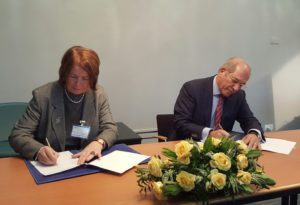
Since 2002, IUPAC has organized workshops with OPCW to identify and review advances in science and technology relevant to the Convention. These workshops have provided information to OPCW that has been used to issue reports at Review Conferences of the Chemical Weapons Convention. At these Review Conferences, held every five years as called for in the Convention, the States Parties review the past five-year period and work to set direction for the next five years. The workshops deal with advances in development of analytical techniques relevant to on-site and off-site detection and verification, the evolving regulatory environment, the convergence of chemistry and biology, emerging technologies and related areas. Reports on the outcomes and findings of the workshops have appeared in Pure and Applied Chemistry, [19-21] leading to reports by the OPCW SAB [22-24]. Most recently, in 2017 IUPAC, with OPCW, the U. S. National Academies, the Brazilian Chemical Society and the Brazilian Academy of Sciences organized and held a workshop on Innovative Technologies for Chemical Security, which included presentations by scientists and engineers who work in fields beyond chemistry but whose research yields new knowledge applicable to the work of the OPCW. A summary of the workshop, along with several papers on these new technologies, appear in the October 2018 issue of Pure and Applied Chemistry [25-27].
The IUPAC President has addressed the annual Chemical Weapons Convention Conference of States Parties since 2014, and the remarks of the IUPAC President are made public by the OPCW [28]. IUPAC and OPCW Technical Secretariat staff organized a side event on IUPAC-OPCW collaboration at the Fourth Review Conference in November 2018, as part of an initiative to deepen the ties between the two organisations (see IUPAC project 2018-022-3-020 and refs therein).
Several IUPAC volunteers contributed in their capacities as individual scientists to The Hague Ethical Guidelines [29]. These Guidelines are a set of elements for codes of ethics that can be used to develop or revise codes of conduct for organizations that deal with chemicals of relevance to the Convention (Fig 3). The primary guideline states that, “…achievements in the field of chemistry should be used to benefit humankind and the environment.” IUPAC has officially endorsed the Guidelines [30-31].

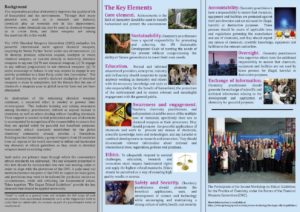
OPCW Technical Secretariat staff are contributing to the work of IUPAC standing committees, for example with an observer on the Committee on Chemistry Education, and are participating in the Interdivisional Committee on Green Chemistry for Sustainable Development. IUPAC volunteers have served on working groups of the OPCW SAB, including the working group on education and outreach [32], whose work led to the establishment of an Advisory Board on Education and Outreach (ABEO) [33]. IUPAC has permanent observer status on the ABEO [Fig. 4].
IUPAC and OPCW volunteers collaborated on an IUPAC project to develop a set of educational web resources about the ethical issues around chemicals with multiple uses, including possible utility as chemical weapons. The resources can be found on the Web [34].
OPCW staff and IUPAC volunteers have collaborated on a series of symposia and workshops at scientific meetings and OPCW events; for example, a series of workshops for industrial chemists in Russia on Responsible Care®. OPCW staff have made several presentations and addresses at IUPAC events, including video addresses by the OPCW Director General at the World Chemistry Congresses in 2013 and 2017 and in person at the International Conference on Chemistry Education in 2012. An OPCW session was held at the IUPAC Green Chemistry Conference in 2014, and IUPAC volunteers participated in the 2016 event entitled, “Chemical Safety and Security in a Technologically Evolving World” [35]. The spring 2016 online ConfChem conference focused on OPCW with endorsement from IUPAC; a special issue of Pure and Applied Chemistry included papers from the ConfChem [36].
The OPCW Conference Support programme, one of OPCW’s capacity building programmes, has provided travel support for scientists from developing countries to attend IUPAC conferences [37].
4Current Challenges and Future Prospects
The Convention is a treaty intended to counter and eliminate the threat of chemical weapons for all time to come. This article has highlighted successes of the OPCW, and how the Convention serves to facilitate engagement of scientists in international efforts for chemical disarmament and non-proliferation. Unfortunately, in the current security environment, the norms against the use of chemical weapons are facing significant challenges [38].
From 2013, beginning with the United Nations-led mission to the Syrian Arab Republic [39], OPCW inspectors have increasingly taken part in non-routine inspection and verification activities [40, 41], many involving investigations, analysis, and fact-finding related to allegations of the use of chemical weapons [10, 42, 43]. Technical assistance missions have also been dispatched to Iraq [44], and the United Kingdom of Great Britain and Northern Ireland [45, 46]; in both cases the use of a chemical weapon agent was confirmed. The use of a nerve agent against an individual in Malaysia has also been reported [47], and there is a recent report of a thwarted ricin attack in Germany [48]. Additionally, there have been considerably more allegations of the use of chemical weapons in Syria than can be investigated [43]. Decisions by the States Parties of the Convention on chemical threats from non-State Actors (e.g. terrorists) [49] and addressing the use of chemical weapons [50] exemplify the urgency of these challenges.
Technological change can also pose challenges to disarmament and nonproliferation, whether real or perceived that cannot be ignored. Technological change may also enable capabilities that enhance implementation of the Convention, and there is a need for the OPCW to engage with scientific experts to seize upon such opportunities [51, 52].
Over the course of OPCW’s history, stockpile destruction has taken up the majority of inspection efforts. With completion of this task in sight, and given the challenges highlighted above, OPCW’s work has been progressively shifting from the disarmament of chemical weapons to preventing their re-emergence [53]. A task that demands increased scientific literacy amongst decision makers, the retention of chemical weapons-related knowledge and expertise, and leveraging the reach and influence of scientific communities in promoting the norms against harmful use of chemicals. Scientific inputs for discussions at the Fourth Review Conference were submitted from the OPCW SAB, including recommendations on the need to maintain and to grow partnerships across the scientific community. Chemical societies and chemical industry from across the world have expressed support for the work of the OPCW [54-59], and the partnership with IUPAC is critical component of these efforts.
* Cover: “Advisory Board on Education and Outreach (ABEO) – Supporting the OPCW’s engagement with external partners.” https://www.opcw.org/about-us/subsidiary-bodies/advisory-board-education-and-outreach
References
- OPCW. Convention on the Prohibition of the Development, Production, Stockpiling and Use of Chemical Weapons and on their Destruction, Organisation for the Prohibition of Chemical Weapons (OPCW), The Hague, The Netherlands (1997). - https://www.opcw.org/chemical-weapons-convention
- For a complete list of the States Parties of the Chemical Weapons Convention - https://www.opcw.org/about-us/member-states
- OPCW. National Implementation of the CWC, OPCW Fact Sheet Number 10, Organisation for the Prohibition of Chemical Weapons (OPCW), The Hague, The Netherlands (2017). - https://www.opcw.org/sites/default/files/documents/Fact_Sheets/English/Fact_Sheet_10_-_national_implementation.pdf
- OPCW. OPCW by the Numbers - https://www.opcw.org/media-centre/opcw-numbers
- Nobelprize.org Nobel Peace Prize 2013 - https://www.nobelprize.org/prizes/peace/2013/summary/
- M. J. Field, T. W. Wymore. Phys. Scr. 89:108004 (2014) -
- OPCW. Eliminating Chemical Weapons and Chemical Weapons Production Facilities, OPCW Fact Sheet Number 6, Organisation for the Prohibition of Chemical Weapons (OPCW), The Hague, The Netherlands (2017). - https://www.opcw.org/sites/default/files/documents/Fact_Sheets/English/Fact_Sheet_6_-_destruction.pdf
- OPCW. Three Types of Inspections, OPCW Fact Sheet Number 5, Organisation for the Prohibition of Chemical Weapons (OPCW), The Hague, The Netherlands (2017). - https://www.opcw.org/sites/default/files/documents/Fact_Sheets/English/Fact_Sheet_5_-_Inspections.pdf
- OPCW. Monitoring Chemicals with Possible Chemical Weapons Applications, OPCW Fact Sheet Number 7: Organisation for the Prohibition of Chemical Weapons (OPCW), The Hague, The Netherlands (2017). - https://www.opcw.org/sites/default/files/documents/Fact_Sheets/English/Fact_Sheet_7_-_Schedule_of_chemicals.pdf
- OPCW. Fact-Finding Mission - https://www.opcw.org/fact-finding-mission
- OPCW. Assistance and Protection Against Attack with Chemical Weapons, OPCW Fact Sheet Number 8, Organisation for the Prohibition of Chemical Weapons (OPCW), The Hague, The Netherlands (2017). - https://www.opcw.org/sites/default/files/documents/Fact_Sheets/English/Fact_Sheet_8_-_assistance.pdf
- OPCW. Guidelines for States Parties Requesting a Rapid Response and Assistance Mission, S/1429/2016, Organisation for the Prohibition of Chemical Weapons (OPCW), The Hague, The Netherlands (2016). - https://www.opcw.org/sites/default/files/documents/S_series/2016/en/s-1429-2016_e_.pdf
- OPCW. Promoting Economic and Technical Development through Chemistry, OPCW Fact Sheet Number 9, Organisation for the Prohibition of Chemical Weapons (OPCW), The Hague, The Netherlands (2017). - https://www.opcw.org/sites/default/files/documents/Fact_Sheets/English/Fact_Sheet_9_-_international_cooperation.pdf
- For further information on OPCW’s capacity building programmes. - https://www.opcw.org/resources/capacity-building
- (a) J. E. Forman, C. M. Timperley. Chemical Disarmament in a Technologically Evolving World, in: E. T. Contis, A. Campbell, B. Miller, D. Phillips (Eds), Responsible Conduct and Ethical Practice in Chemical Sciences Research, Safety, Security, Education, and Risk Management: The Catalytic Role of the Professional/Learned Society, American Chemical Society, Washington D.C., in press (2018); and (b) J. E. Forman, C. M. Timperley, S. Sun, D. van Eerten. Pure Appl. Chem. 99(10), 1507 (2018). - https://doi.org/10.1515/pac-2018-0902
- Leiv K. Sydnes.IUPAC, OPCW, and the Chemical Weapons Convention. Chemistry International -- Newsmagazine for IUPAC (2013), 35(4), pp. 4-8. - https://doi.org/10.1515/ci.2013.35.4.4
- OPCW. OPCW and International Union of Pure and Applied Chemistry Take Partnership to New Level. - https://www.opcw.org/news/article/opcw-and-international-union-of-pure-and-applied-chemistry-take-partnership-to-new-level/
- The Memorandum of Understanding is available online. - https://www.opcw.org/sites/default/files/documents/Industry/OPCW_IUPAC_Signed_MoU_01Dec2016.pdf
- IUPAC Workshop, Impact of Scientific Developments on the Chemical Weapons Convention, Bergen, Norway, 30 June – 3 July 2002. Pure Appl. Chem. 74(12), 2229 2352 (2002). - https://www.iupac.org/publications/pac/74/12/index.html
- M. Balali-Mood, P. S. Steyn, L. K. Sydnes, R. Trapp. Pure Appl. Chem. 80(1), 175 (2008). - https://doi.org/10.1351/pac200880010175
- K. Smallwood, R. Trapp, R. Mathews, B. Schmidt, L. K. Sydnes. Pure Appl. Chem. 85(4), 851 (2013). - https://doi.org/10.1351/PAC-REP-12-11-18
- OPCW. Report of the Scientific Advisory Board on Developments in Science and Technology, RC-1/DG.2, Organisation for the Prohibition of Chemical Weapons: The Hague (2003). - https://www.opcw.org/sites/default/files/documents/CSP/RC-1/en/RC-1_DG.2-EN.pdf
- OPCW. Report of the Scientific Advisory Board on Developments in Science and Technology, RC-2/DG.1, Organisation for the Prohibition of Chemical Weapons: The Hague (2008). - https://www.opcw.org/sites/default/files/documents/CSP/RC-2/en/RC-2_DG.1-EN.pdf
- OPCW. Report of the Scientific Advisory Board on Developments in Science and Technology for the Third Special Session of the Conference of the States Parties to Review the Operation of the Chemical Weapons Convention, RC-3/DG.1, Organisation for the Prohibition of Chemical Weapons: The Hague (2012). - https://www.opcw.org/sites/default/files/documents/CSP/RC-3/en/rc3dg01_e_.pdf
- Pure and Applied Chemistry. Volume 90, issue 10 (2018). - https://www.degruyter.com/view/j/pac.2018.90.issue-10/issue-files/pac.2018.90.issue-10.xml
- OPCW. Report of the Scientific Advisory Board's Workshop on Emerging Technologies, SAB-26/WP.1, Organisation for the Prohibition of Chemical Weapons (OPCW), The Hague, The Netherlands (2017). - https://www.opcw.org/sites/default/files/documents/SAB/en/sab26wp01_SAB.pdf
- B. West. Chem. Int. 40(1), 37 (2018). - https://doi.org/10.1515/ci-2018-0118
- From the Twenty-Second Conference of the States Parties in 2017. - https://www.youtube.com/watch?v=aKYvv795Omk
- OPCW. The Hague Ethical Guidelines. - https://www.opcw.org/special-sections/science-technology/the-hague-ethical-guidelines/
- OPCW. IUPAC endorses The Hague Ethical Guidelines. - https://www.opcw.org/media-centre/news/2016/05/iupac-endorses-hague-ethical-guidelines
- IUPAC. IUPAC endorses The Hague Ethical Guidelines. - https://iupac.org/iupac-endorses-the-hague-ethical-guidelines/
- OPCW. Education and Engagement: Promoting a Culture of Responsible Chemistry: Final Report of the Scientific Advisory Board’s Temporary Working Group. SAB/REP/2/14, Organisation for the Prohibition of Chemical Weapons: The Hague (2014). - https://www.opcw.org/sites/default/files/documents/SAB/en/Education_and_Engagement-v2.pdf
- OPCW. Advisory Board on Education and Outreach. - https://www.opcw.org/about-us/subsidiary-bodies/advisory-board-education-and-outreach
- The Multiple Uses of Chemistry. - https://multiple.kcvs.ca/
- American Chemical Society, Division of Chemical Education, Committee on Computers in Chemical Education DivCHED CCCE: Committee on Computers in Chemical Education. 2016 Spring ConfChem: Science, Disarmament, and Diplomacy in Chemical Education: The Example of the Organisation for the Prohibition of Chemical Weapons (2016). - https://confchem.ccce.divched.org/2016SpringConfChem
- Pure and Applied Chemistry. Volume 89, issue 2 (2017). - https://www.degruyter.com/view/j/pac.2017.89.issue-2/issue-files/pac.2017.89.issue-2.xml
- OPCW. Capacity Building: Conference Support Programme. - https://www.opcw.org/resources/capacity-building/international-cooperation-programmes/conference-support-programme
- Everyone Has a Lot at Stake: A Q&A with Fernando Arias, the new director-general of the Organisation for the Prohibition of Chemical Weapons. Arms Control Today (2018). - https://www.armscontrol.org/act/2018-10/features/everyone-lot-stake-fernando-arias-opcw
- United Nations Mission to Investigate Allegations of the Use of Chemical Weapons in the Syrian Arab Republic, A/68/663-S/2013/735, United Nations Secretary-General, New York, USA (2013). - https://unoda-web.s3.amazonaws.com/wp-content/uploads/2013/12/report.pdf
- In the Syrian Arab Republic, these operations have included an OPCW-United Nations Joint Mission to remove and destroy chemical weapons that ran from 16 October 2013 to 30 September 2014, and a Declarations Assessment Team (see: OPCW. Report on the Work of the Declaration Assessment Team, EC-85/DG.25, Organisation for the Prohibition of Chemical Weapons (OPCW), The Hague, The Netherlands (2017). - https://opcw.unmissions.org/
- In Libya, these operations have included the removal, transport out of country and verification of destruction of chemicals, see: Libya and the OPCW. - https://www.opcw.org/media-centre/featured-topics/libya-and-opcw
- OPCW. Summary of the First Meeting of the Scientific Advisory Board’s Temporary Working Group on Investigative Science and Technology, SAB-27/WP.1, Organisation for the Prohibition of Chemical Weapons (OPCW), The Hague, The Netherlands (2018). - https://www.opcw.org/sites/default/files/documents/SAB/en/sab-27-wp01_e_.pdf
- OPCW. Note by the Technical Secretariat: Summary Update of the Activities Carried out by the OPCW Fact-Finding Mission in Syria, S/1677/2018, Organisation for the Prohibition of Chemical Weapons (OPCW), The Hague, The Netherlands (2018). - https://www.opcw.org/sites/default/files/documents/2018/10/s-1677-2018%28e%29.pdf
- See paragraph 1.10 of: OPCW. Report of the OPCW on the Implementation of the Convention on the Prohibition of the Development, Production, Stockpiling and Use of Chemical Weapons and on their Destruction in 2016, C-22/4, Organisation for the Prohibition of Chemical Weapons (OPCW), The Hague, The Netherlands (2017). - https://www.opcw.org/sites/default/files/documents/CSP/C-22/en/c2204_e_.pdf
- OPCW. Summary of the Report on Activities Carried Out in Support of a Request for Technical Assistance by the United Kingdom of Great Britain and Northern Ireland (Technical Assistance Visit TAV/02/18), S/1612/2018, Organisation for the Prohibition of Chemical Weapons (OPCW), The Hague, The Netherlands (2018). - https://www.opcw.org/sites/default/files/documents/S_series/2018/en/s-1612-2018_e___1_.pdf
- OPCW. Summary of the Report on Activities Carried Out in Support of a Request for Technical Assistance by the UK (Technical Assistance Visit TAV/03/18 and TAV/03B/18, “Amesbury Incident”), S/1671/2018, Organisation for the Prohibition of Chemical Weapons (OPCW), The Hague, The Netherlands (2018). - https://www.opcw.org/sites/default/files/documents/S_series/2018/en/s-1671-2018_e_.pdf
- T. Nakagawa, A. T. Tu. Forensic Toxicol. 36, 542 (2018). - https://doi.org/10.1007/s11419-018-0426-9
- German prosecutors arrest man over alleged ricin attack plot. The Guardian, 14 June 2018. - https://www.theguardian.com/world/2018/jun/14/german-prosecutors-arrest-man-over-plot-to-launch-ricin-attack
- OPCW. Decision: Addressing the Threat Posed By the Use of Chemical Weapons by Non-State Actors, EC-86/DEC.9, Organisation for the Prohibition of Chemical Weapons (OPCW), The Hague, The Netherlands (2017). - https://www.opcw.org/sites/default/files/documents/EC/86/en/ec86dec09_e_.pdf
- OPCW. Decision: Addressing the Threat from Chemical Weapons Use, C-SS-4/DEC.3, Organisation for the Prohibition of Chemical Weapons (OPCW), The Hague, The Netherlands (2018). - https://www.opcw.org/sites/default/files/documents/CSP/C-SS-4/en/css4dec3_e_.doc.pdf
- J. E. Forman , C. M. Timperley, P. Aas, M. Abdollahi, I. P. Alonso, A. Baulig, R. Becker-Arnold, V. Borrett, F. A. Cariño, C. Curty, D. Gonzalez, Z. Kovarik, R. Martínez-Álvarez, R. Mikulak, E. de Souza Nogueria, P. Ramasami, S. K. Raza, V. Rubaylo, A. E. M. Saeed, K. Takeuchi, C. Tang, F. Trifirò, F. M. van Straten, F. Waqar, V. Zaitsev, M. S. Zina, K. Grolmusová, G. Valente, M. Payva, S. Sun, A. Yang, D. van Eerten. Pure Appl. Chem. 90(10), 1527 (2018). - https://doi.org/10.1515/pac-2018-0908
- OPCW. Report of the Scientific Advisory Board on Developments in Science and Technology for the Fourth Special Session of the Conference of the States Parties to Review the Operation of the Chemical Weapons Convention, RC-4/DG.1, Organisation for the Prohibition of Chemical Weapons (OPCW), The Hague (2018). - https://www.opcw.org/sites/default/files/documents/CSP/RC-4/en/rc4dg01_e_.pdf
- OPCW. The OPCW in 2025: Ensuring a World Free of Chemical Weapons. S/1252/2015, Organisation for the Prohibition of Chemical Weapons (OPCW), The Hague (2015). - https://www.opcw.org/sites/default/files/documents/S_series/2015/en/s-1252-2015_e_.pdf
- IUPAC. Letter of Support 23 November 2016. - https://www.opcw.org/sites/default/files/documents/Industry/IUPAC-OPCW_letter.pdf
- European Chemical Society. The Seville Declaration on the Use of Chlorine in Warfare. European Association for Chemical and Molecular Sciences, October 2016. - https://www.euchems.eu/seville-declaration-use-chlorine-warfare/
- OPCW. Chemical Industry Councils and Scientific Societies Condemn Use of Chlorine as Weapon, 29 November 2016. - https://www.opcw.org/media-centre/news/2016/11/chemical-industry-councils-and-scientific-societies-condemn-use-chlorine
- OPCW. ACS and ACC Response to September 2016 Chlorine Incident in Syria. - https://www.acs.org/content/acs/en/policy/publicpolicies/sustainability/acs-and-acc-response-to-chlorine-incident-in-syria.html
- American Chemical Society. The American Chemical Society condemns chemical weapons use in Syria, 10 April 2018. - https://www.acs.org/content/acs/en/pressroom/newsreleases/2018/april/acs-statement-on-chemical-weapons-in-syria.html
- IUPAC. Letter of Support 18 April 2018. - https://www.opcw.org/sites/default/files/documents/Industry/IUPAC-OPCW_Letter_19April2018__002_.pdf
- For further information see: OPCW. Fourth Review Conference Documents. - https://www.opcw.org/rc-4




